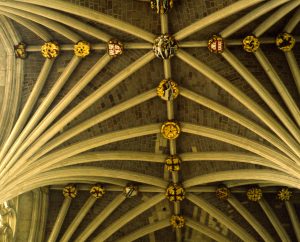 Exeter Cathedral was rebuilt in the English Decorated Gothic Style primarily between 1275 and 1340. This re-building project extended from the Lady Chapel at the east end to the carvings of the image screen on the west front. Some features of the previous Norman cathedral remain, however. The side towers were opened to make the Norman transepts of the new Gothic design. The new Gothic nave was built on the foundation of the Norman cathedral using the Norman walls up to the sills of the windows. Yet, the construction of the new edifice in just two-thirds of a century achieved a homogeneous consistency that makes Exeter the best example of English Decorated Gothic architecture.
Exeter Cathedral was rebuilt in the English Decorated Gothic Style primarily between 1275 and 1340. This re-building project extended from the Lady Chapel at the east end to the carvings of the image screen on the west front. Some features of the previous Norman cathedral remain, however. The side towers were opened to make the Norman transepts of the new Gothic design. The new Gothic nave was built on the foundation of the Norman cathedral using the Norman walls up to the sills of the windows. Yet, the construction of the new edifice in just two-thirds of a century achieved a homogeneous consistency that makes Exeter the best example of English Decorated Gothic architecture.
Decorated Gothic architecture is more grandiose than the simpler Early English Gothic style found in places like Salisbury Cathedral, but it does not seem as extreme as the Flamboyant Gothic one finds in France. In Exeter, the vaulting is boldly ribbed and features beautifully carved roof bosses at the intersection of ribs. Exeter’s is the longest unbroken Gothic vault in England because there is no central tower to interrupt it. A picture of the elaborate tierceron vaulting in Exeter is shown above. It gets its name from some of the ribs called tiercerons which rise from the side pillars but do not all go to the centre of the vault. Rather, they meet the cross pieces.
Another feature of the Decorated Gothic style is the tracery found in the windows. There are variations in the tracery design from one window to the next, but each window on one side of the cathedral will have its tracery duplicated in the corresponding window on the opposite side even though the stained glass in the two windows may be quite different. Much of Exeter’s stained glass had to be replaced after the damage of World War II but all the surviving medieval stained glass in the great east window was removed and hidden away early in the war and thus saved.
The north doorway on the west front was one of the last parts of the building to be finished and is in the later perpendicular Gothic style. At the east end of the south side of the nave, there is a seldom-used door left over from the Norman period called the Brewer Door and of course, there are the two Norman towers mentioned earlier. These Norman style features are the exceptions. Most of the architecture of this magnificent building in Exeter is a perfect example of the English Decorated Gothic style.
For more information on the Exeter Cathedral Architecture, click on http://www.exeter-cathedral.org.uk/_assets/Education/141107%20A%20History%20of%20Exeter%20Cathedral.pdf .
Tags: Chaucer's England, historical fiction, medieval mysteries